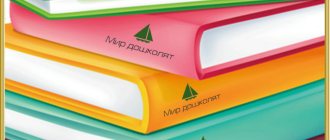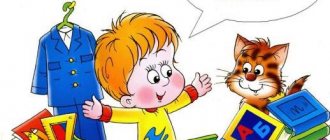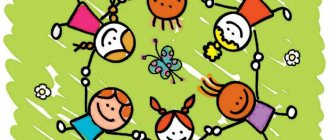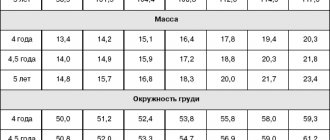Distinguish between "left" and "right"
For studying in general and so as not to confuse the concepts of “clockwise” and “counterclockwise” as well.
Have a general understanding of time
We explain to the child the concepts of “yesterday”, “today”, “tomorrow”; "past present Future"; “morning”, “day”, “evening”, “night”, “day”. Often children themselves associate time with a specific event: “in the morning I did exercises”, “at lunch I ate soup”, “before going to bed I brushed my teeth”, etc. Therefore, when explaining the above concepts, it is best for a parent to tie specific events to them.
Correct your child carefully if he makes mistakes somewhere. It is important that he does not develop a false understanding of time.
Have you successfully completed the preparatory stage? Now we can teach the child to understand time using a clock with arrows.
We teach a child to understand time using a clock with arrows
Oh, these adults! And why do they only allow you to watch cartoons for about 15 or 20 minutes? For children, time is an incomprehensible number. To figure out where it comes from, you will need a watch with hands. If there are no such things at home, but only electronic ones, it will be completely difficult for the child to understand what time is. Therefore, the first step for a parent is to acquire a wall clock or a special children's clock, on which the numbers and arrows will be clearly visible.
Introducing the child to the structure of the clock
First, explain to your child the concepts of “dial”, “day”, “hours”, “minutes”, “seconds”; “exactly one hour”, “half an hour”, “quarter of an hour”, tell us about the hour, minute, second hands. Please note that all arrows have different lengths. Let the child observe which of the arrows is the fastest and which one practically stands still. And how long does it take for each to complete the whole circle?
Be sure to connect all the basic concepts into one logical chain: there are 24 hours in a day, 1 hour is 60 minutes, and 1 minute is 60 seconds. Do not ignore the concepts of “clockwise” and “counterclockwise”. Let your child understand that time always moves forward.
We teach a child to “read” the hour and minute hands at the same time
First of all, teach your child to count minutes in intervals divisible by 5. Minutes are not indicated on a regular clock, so this skill needs to be practiced. You can come up with a legend that each number on the dial has its own “shadow”. 1 is 5 minutes, 2 is 10 minutes, 3 is 15 minutes, etc. The “shadow” can only be seen when the minute hand is pointing to the number. When your child can easily navigate five-minute intervals, tell him about smaller intervals.
The hour hand also has two meanings. In the first half of the day we see the numbers as they appear on the dial, but after a hearty afternoon snack at 12:00 they begin to “get fat”: 1 turns into 12, 2 into 14, etc. A funny analogy will help your child grasp the meaning faster.
The ability to determine time using a clock with hands must be reinforced with specific examples. Draw your child's attention to the clock more often. Correct him if he says the time incorrectly.
The best gift for a child who is learning to tell time by clock is a wristwatch. With them, he will become more willing to answer the question “What time is it?” and will definitely ask you about this in order to check with his “walkers”.
Ideally, a child should have a “draft” watch that he can “exploit” as he pleases: set the time on it, add “shadows” to each of the numbers, sign the names of the hands. For training, you can use an old non-working clock (wall or table clock). You need to remove the glass in them so that the hands can be rotated. If you haven't found one like this at home, we suggest you make your own.
Explaining the essence of time
By the age of three, children, as a rule, know what morning, afternoon, evening are, and how they differ. To teach this, you can use visual aids: cards, pictures, cubes, books. Tell your child when the sun rises, when it sets, and what we do at certain times of the day. For example, in the morning we wake up, wash our face, brush our teeth, and have breakfast. At lunch we eat soup and go to bed for the day.
In the evening it gets dark, the whole family has dinner, then the baby bathes, listens to a fairy tale, and goes to bed. As you know, children perceive new information better during play. Let your favorite toys (dolls, bears, bunnies) wake up, have breakfast, go for a walk, and go to bed. At the same time, talk about what time of day it is for the toys, explain why right now they should go to bed or wake up.
Interesting : We warn correctly about the punishment. Useful methods and advice from psychologists
Making homemade watches
A homemade clock will help make time more tangible. If you have the necessary materials, their creation will take no more than 15 minutes.
How to make a watch yourself
The basis for the dial can be a disposable plate or a circle made of cardboard. We draw the circle in half, then in half again and apply the first numbers. Next, carefully divide each quarter into three parts and add the remaining numbers. The dial is ready, which means it's time to attach the hands. We cut them out of cardboard of different colors and attach them to the circle using a button. We place the resulting model of the clock next to the real clock.
When creating your own watch, it will be useful to go over the concepts you have already learned. We drew the circle into four parts - we remembered about the “quarter hour”, attached an hour hand - we remembered its function, etc.
Homemade watches may look unusual. For example, like this:
We begin direct training
Before. When starting training, it is very important to remember a few basic requirements:
- Never put pressure on your baby . It is important to strike a balance between training intensity, rewards, and rest. Classes should always be interesting and bring joy.
- Don't have too long training sessions . It is most convenient to spend a few minutes mastering counting skills and dividing complex material into simpler segments.
- Always show the practical importance of using the skill learned . For example, the baby will be able to determine for himself when his favorite cartoon starts or the time allotted for games.
Don’t forget about the numerous online tools and special toys that help you absorb new information much faster. They can be easily found online or bought in a special store.
Games and tasks with a clock
Games and tasks will help you strengthen your ability to tell time using a clock.
"What time is it now"
Show your child how the arrows move. Change their position and call the time. Then have the child do the same exercise. Change the time clockwise and counterclockwise.
Let's complicate the game. We show the time on the clock and associate it with events (“it’s 7:00”, at this time we wake up”, “it’s 18:00”, at this time we have dinner”, etc.). Now we invite the child to pretend to live the whole day.
“Drawing pizza”
The good thing about a homemade dial is that you can make your own notes on it. Ask your child to draw lines from the center of the dial to the numbers and shade each sector with a different color. You will get a “colored pie” or “colored pizza” (this will make it easier to understand 5-minute intervals). Label the second values of each number (2 - 10, 3 - 15) and minutes (from 1 to 60).
"Daily regime"
Take a piece of paper, write down the daily routine, and together with your child, illustrate it with images of a clock that indicates a period of time (8:00 - time for school, 15:00 - time to do homework, etc.). Hang it above your child's bed or desk. This way the child will learn not only to do everything on time, but also to navigate in time.
Pay your child's attention to how much time he spends on this or that action. This way you can teach him to be punctual from an early age.
“Two options for telling the time”
Tell your child that time can be called in different ways (for example, 1 hour 18 minutes is eighteen minutes past two, etc.). Write down the second, more complex option on a piece of paper, and indicate the hint numbers to make it easier for the child to cope (example: “five minutes to eight”, the hint numbers are 9, 5, 5, 1). Gradually remove the prompts.
Add variety to your learning - make your own clock
Another way to make the learning process much more interesting and memorable is making your own watches. They can be made from different materials; in most cases, cardboard or colored paper or wire are used.
The arrows can also be mounted on a beautiful plate. In this case, you can buy paints and paint the plate the way you want.
Another option is to make a beautiful watch with a dial on which the main positions are marked with pebbles, shells, leaves or other objects.
Teaching time and consolidating material in a playful way
As you know, children perceive information best in a playful way, so parents should take care to create an interesting and fun learning process.
Using the constructor
You can purchase a special kit in the store, which includes a wooden construction set and a notebook with assignments. Thanks to the additional developmental materials that are in the notebook, the baby will not only master the dial, but also prepare for school.
The wooden construction set is a dial with numbers from 1 to 12 and from 1 to 24. The minutes and seconds are marked on the construction set, and there are also movable hands with which the baby can set the time. The constructor can be colored as you wish.
The child assembles such a construction set independently, which will initially help to interest him in the game.
Interesting online games
Today, many children tell time only by electronic mechanisms, because it is much easier. The online game “Learn Time” helps you understand what time a mechanical watch shows. The game invites you to look at an electronic watch and, among the proposed mechanical options, find one that shows the same numbers. After confirming the choice, the baby moves on to the next task.
The educational online game “Watches – Studying Time” introduces the young player to mechanical and electronic mechanisms.
The game is designed for children from 3 to 5 years old. Here you can see a mechanical clock in the shape of a house where a cuckoo lives. There is an electronic clock in the right corner of the screen. First, they determine the time on a mechanical clock, and then set it on an electronic clock. The baby needs to follow the view from the window in order to correctly determine the time of day.
Games to consolidate results
Reinforce your learning with simple practical tasks in a playful way. When performing a certain action: going to bed, waking up, setting the table for dinner, ask your child to watch and tell you what time the clock shows.
When turning on cartoons, a computer game, going on a visit or for a walk, clearly state the planned time interval: 15 minutes, half an hour, an hour - and pay attention to the location of the arrows.
Ask your child for help when doing household chores, for example, ask him to remind you to turn off the stove in 5 minutes, say that it’s time for dinner if the big arrow is on the number 6. Teach punctuality: when going somewhere, talk about the time for getting ready and traveling .
Here are some ways to master time categories playfully:
- " Tell me what time it is ." Set the time on the layout. Take a teddy bear, tell your baby that he is in a hurry to get home and asks what time it is. The kid must answer, if he can’t, help him.
- Make the exercise more difficult by changing the position of the hands on the dial. Repeat several times to consolidate the result.
- " Make a daily routine ." Take the clock model in your hands. Set the arrows to the time when the baby usually wakes up, then, moving their progress, discuss all the actions that he performs during the day, in the morning, at lunch and in the evening.
- " True False ". Place arrows on the layout, ask the child if it is correct that it is such and such a time. He must confirm or refute what was said. If he is in difficulty, ask leading questions.
- " Schedule ". Invite your child to start playing bus station. To dispatch the cars, he himself needs to set the clock hands to the specified time. Use whole numbers first, then complicate the task by using definitions such as “noon”, “quarter of an hour”.
"Cubes"
To play you will need 4 dice and our homemade clock. We throw the dice in pairs. The first pair of cubes will determine the hours, the second pair will determine the minutes. The time that has fallen must be set on a toy watch.
There are also interactive games with clocks on the LogicLike platform. We have more than 3,500 exciting tasks for children of preschool and primary school age that help develop logic, thinking, and memory.
Poems about time for children
It is very good to use short poems during the learning process to remember the basics of time. This will make it more fun and easier for the child to immerse himself in the process of learning this concept.
Here are the funniest and most interesting poems.
Hours and minutes will pass, They will gather together in a day. They have twenty-four hours, and the hands work wonders.
The arrow passes the first circle, - Noon comes to visit us, And she hurries again to mark hour after hour.
The arrow has passed the second circle, - Midnight came to visit us, The day passed, and the night passed, - They ran away for a day.
***
The seconds are counting, the Dwarf has taken the lead, but he doesn’t know yet how short a second is.
Look at the clock - The hands are not here for show: They indicated for us the Second, the minute and the hour.
A second is a thin one, A minute is a long one, And a short one is an hour: This happens every time.
Sixty seconds have passed - We have approached the minute. Well, sixty minutes together will give you a whole hour.
***
The walkers suddenly began. What happened, what happened? The arrows immediately stopped winding Day around the axle. The gray-eyed dial looked at them gloomily: “If you are not to blame, is someone still to blame?” “Maybe,” thought Roma, “the pendulum has no strength, try with your head down. Swing for so many years!”
***
There is a clock on the wall in the room. It is not hanging for decoration. And to the rhythm of knocking: tick-tock, tick-tock. Everyone is given a conventional sign. Day and night change outside the window. The dawn is wonderful. And then for a person all year round, the time has come for daytime worries.
Watch another interesting video about teaching time to children.
A child should be taught to value time and use it wisely from childhood. Ask him what good, useful or enjoyable can be done in an hour, a minute, half an hour. Don’t expect quick results, don’t rush the learning process: time orientation is a complex skill.
The smaller the child, the shorter the lesson should be. So that he quickly learns to understand complex concepts, learn to understand the movement of the mechanism, find out what time it is, buy him a bright wristwatch. This way the child will quickly begin to use the acquired knowledge in practice.
When to teach your child to tell time
The child should be introduced to the basic division into the future, past, present, seasons of the year and day as early as possible. Two- to three-year-old children can easily navigate the concepts of day and night, winter and summer, as well as today and tomorrow. Parents should teach their baby to name the 12 months and seasons.
To teach a child to tell time using a clock, the baby must grow up a little. Experts consider the optimal age to be 5-6 years, because the child will subsequently need this skill at school.
Let’s start with the very concept of time: how to navigate it, what a day is
As has already been said, before introducing a child to a clock with hands, it is necessary for him to understand the very concept of time (this can be done long before lessons with a clock, as early as 3–4 years old). The difficulty is that time is abstract; it cannot be seen or touched with your hands. Information should be divided into specific blocks.
- Time does not stand still, it moves all the time, “flows ”. There is the past - what has already happened and will never return, the present - one moment that is happening now, the future - events that are yet to come. It is necessary to give specific examples: “This morning you walked in the yard, now we are talking, and in the evening we will have a delicious dinner.” It is also useful to look at a photo album (“Look how small you were and what you have become”). You should definitely use didactic materials, for example, the game “First and Then”. The child is offered pictures of objects and objects, and then other cards depicting what happened to them over time. The preschooler's task is to make pairs of cards.
Such material will help the child feel that time does not stand still, but moves all the time.
- There are seasons that follow each other. This is quite easy for a child to understand. The explanation is again supported by clarity. It should also be mentioned that the year is divided into months, the month into weeks, and each week has 7 days.
Usually children easily understand what the seasons are
- The key concept in this case will be parts of the day. The child must learn that the day is divided into 4 parts. In total they last 24 hours. Pictures, as well as associations (“In the morning you go to kindergarten”, “In the evening you go to bed”) will again help you remember the concepts of “morning”, “day”, “evening”, “night”. You can navigate by the sun: in the morning it just rises above the horizon, during the day it is high in the sky, in the evening it descends again, at night the sun disappears, but the moon is visible in the sky).
The key concept for learning will be parts of the day
How to explain to a child what time is
If you ask an adult: “What is time?”, he may answer that it is a certain parameter, or a certain interval between events, or he will express some other philosophical reflection.
Have you ever wondered how a child will answer this question? What is the concept of “time” for him? Do a simple experiment and ask your children. The answers may be very interesting.
To gradually give your child an idea of time, it is necessary to form the following concepts:
- Times of Day;
- season;
- units of time;
- passage of time (fast, long, often, rarely, yesterday, today, tomorrow).
These concepts are given to preschoolers by parents and kindergarten teachers. To do this, they can use the following techniques: conversations, stories, games, poems, riddles. Before explaining clock time to a child, it is important to prepare him for the perception of time in a broader sense.
Seasons
At 3 years old, a preschooler begins to associate weather with seasons. At first, these are primary and pronounced signs: in summer it’s hot, in winter it’s cold.
With growing up, the amount of information gradually increases, and by the age of 7, the child knows the number and order of seasons, the number of months in a year, the order of months, and the classification of months by season.
Children receive all this information by watching the weather, looking at illustrations, memorizing poems, and listening to riddles. For better memory fixation, each month is associated with a natural phenomenon, human activity, or some holiday.
For example: Mom explains to the baby: “Winter has come. Look, it's snowing outside. Let's put on a fur coat, hat and boots. Cold. Children are making a snowman. New Year is coming, we will decorate the Christmas tree, and Santa Claus will bring gifts.”
Particular attention is paid to the calendar. With its help, the child will be able to clearly understand long periods of time: day, week, month, year.
Four times of day
Children begin to learn simple concepts of “day and night” before the age of 3 years. Later they begin to understand the meaning of “morning - evening”. To formulate these concepts, it is recommended to use pictures with the actions of animals or people at different times of the day, didactic games (“When does this happen?”), riddles, and nursery rhymes.
For example, guess the riddle: “The children went for a walk, they are observing. The sun is shining brightly in the sky, the birds are singing happily. (Day)
Note: In order for the child to correctly form concepts about the time of day, before napping you should not automatically say “Good night”, you should wish “Good sleep”.
Hourly intervals
At the age of 5 - 7 years, you can teach children to understand time by clock. How to determine the exact age point?
If a preschooler himself begins to show interest in watches, asks to explain what the watch shows, where the hands are, when his favorite cartoon starts, what time dad will return from work, then your child is ready to learn complex information about hour intervals.
And in order for this information to contribute to the perception of time, and not a superficial understanding of the “numbers” on the clock, the preliminary preparation described above is precisely important.
Where to begin
In a child’s understanding, time is a complex, non-existent concept; it cannot be touched or tasted. The baby understands that everything around him is changing, but he cannot measure or feel the changes.
The first thing you should start getting acquainted with is the basic division of time into the future, present and past. Use simple examples to explain these concepts to your child:
- Future: in the evening we will go for a walk.
- Present: We are playing now.
- Past: in the morning we had breakfast.
Explain the difference between them using clear and interesting words and examples.











